Tag: vineyards
If we’re winter pruning, then Spring must be close
Maintaining a vineyard is a year-round enterprise. Even in the winter, after the vines go into a dormant state, there’s work to be done. In fact, dormant winter pruning is among the most time-consuming work of the year, and some of the most important as well, since it involves decisions that will affect not just the coming season’s growth, but the year after as well.
Most of the objectives of dormant pruning fall under the heading of “balance.” Vines will grow just fine on their own, with no pruning at all, but most of their energy will go toward producing shoots and leaves, rather than grapes. Absent any intervention, the vines will continue to grow skyward for so long as they can find support. The whole purpose of a trellis system and the pruning decisions that go with it are to force the vine to direct its energy toward the production of high-quality fruit rather than vegetative growth.
So we’re looking for balance as we decide which shoots and how many buds to retain. Prune away too much and the vine will be undercropped, producing less fruit than it can reasonably support. Prune away too little and it will be overcropped, producing a profusion of leaves and shoots, as well as an abundance of fruit that is destined to be of low quality.
During the growing season, we’ll drop some fruit from the vine, again to direct energy toward the remaining clusters in the hopes of producing more concentrated and higher-quality grapes. But the first decisions we make that will determine the quantity and quality of the season’s fruit are those made in the dead of winter.
Which is to say, when it’s cold outside. Really, really cold. Not to mention snowing every few days or so. (Or maybe it just seemed that way this winter.) Which is one of the reasons we’ve put off pruning.
The other, more noble reason for delaying our pruning, has to do with timing. It’s better not to prune too early in the season – the untouched vines will survive a cold spell much better than those that have been pruned back, and by waiting, you’ll have more options in the case of a late freeze that damages buds and shoots.
It’s helpful to be able to assess the vine late in the winter for cold injury before deciding which canes to remove and which few to retain. In our little hobby vineyard, we have the luxury of delaying for almost as long as we want to start dormant pruning. Commercial vineyards that have acres of vines to prune, don’t have that luxury. They need to start early enough to be able to finish the job before budbreak. But many vineyards employ a technique of double pruning, going through once early in the winter to trim away the shoots they know won’t be used, and returning later to finish up the job.
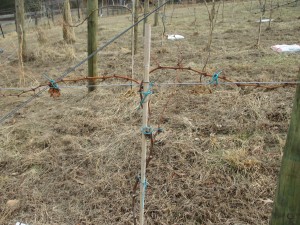
This cane-pruned vine is finished on the left arm, only partly done on the right. Click on the picture for a better view.
Our vines are all trained to a trellis system known as vertical shoot positioning, of VSP, and we have adopted a pruning method known as cane pruning. In cane pruning, most of the previous year’s growth is pruned away, and two one-year old shoots, which have now achieved the status of canes, are retained and trained in either direction along the bottom, or fruiting wire. These canes – the one-year old wood – will give rise to new shoots this summer, and these new shoots are the part of the vine that will bear fruit.
At the same time, we’ll be looking for renewal spurs below this year’s fruiting canes. These will be pruned back to one or two buds to provide the fruiting canes for the following year.
I’ve taken a class or two on pruning, and I’ve done lots of reading and studied more videos on the Internet than I can count. So, of course, I should be an expert. And in theory I am. I know a lot about the why’s and how’s of pruning. But the actual pruning – the time when you come face to face with a vine and decide what to lop off and what to keep – that’s a whole different story. I still remember my first pruning session. I was sure that I was going to destroy the vine, and I stared at it for what seemed like hours before I worked up the nerve to make that initial cut. I’ve gotten a little more confident, but only a little. I still spend way too much time on each vine. Fortunately, we only have 230 vines now, so I can get away with it.
When the Vineyard Goddess and I got out a few weeks ago – and yes, we chose a weekend when the temperatures were in the 60s – we realized that we had not maintained the vines as well as we should have in the previous year. No neglect, just the kinds of mistakes you make early on. A number of the vines were just fine, but others lacked the kind of year-old shoots we were looking for to train to the cordon wire.
So, we made some adjustments. On the vines that had perfect one-year old shoots, we cut away everything else and tied these canes down. On those that didn’t, we resorted to a different pruning method called spur or cordon pruning.
In spur pruning, a cordon is tied down to the wire and used year after year. The shoots from the previous year are pruned down to two buds, which will give rise to fruitful wood for the current season. It’s more like a haircut, and most people would say it’s a far easier method of pruning than cane pruning. And it works well for at least the first decade. At some point, however, these cordons grow thick from age and produce fewer spurs. Moreover, they’re more prone to disease. It’s the same with people. The older you get, the more opportunity your body has to develop diseases.
Which method is better? Well, they each have advantages and disadvantages. Jim Law, founder and owner of Linden Vineyards, said he started with spur pruning, which worked well for years, but eventually moved to cane pruning, after the disadvantages – disease in particular – began to outweigh the advantages.
Our thought, however, is that we’ll spur prunes those vines that need it this year, while leaving some buds that we hope will give rise to canes that can be trained to the wire in 2015. And while I remain hopeful that our vines will produce some wonderful fruit thisyear for making wine, I am confident that we’ll do even better next year and better still in each of the succeeding years. After all, this is a learning experience, and Lord knows, we’re learning.
Just off the Grape Press: New Editors
It’s a pleasure to announce that the Vineyard Goddess and I are now co-editors of Grape Press, the quarterly publication of the Virginia Vineyards Association. Our first issue is the just-published Spring 2013 edition, and while we took over editorial responsibilities too late to have had any role in the planning, we spent lots of time collecting articles, working with the authors on final edits, revamping the look of page 1, and dealing with the hundreds (well, dozens and dozens) of little details that come up as you’re going to press.
We’re very excited about this opportunity for a number of reasons. First, lots of folks in the Virginia viticulture community have been 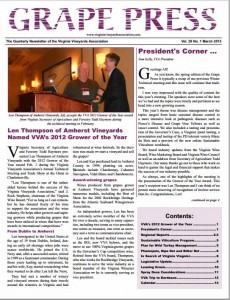 very generous with us, giving hours of their time to assist in our education. Early on, for example, I posted a note to a web site for the Central Virginia Winemakers group asking a question about how much time I should expect to set aside to manage a small vineyard I got lots of responses, and two of the folks who replied to my query hosted us at their vineyard for what amounted to a seminar on growing grapes.
very generous with us, giving hours of their time to assist in our education. Early on, for example, I posted a note to a web site for the Central Virginia Winemakers group asking a question about how much time I should expect to set aside to manage a small vineyard I got lots of responses, and two of the folks who replied to my query hosted us at their vineyard for what amounted to a seminar on growing grapes.
Secondly, we’re big fans of Virginia wine. We attended our first Virginia wine festival some 25 years ago, and while the wines weren’t great back then, some were pretty good, and we thought they all had promise. We were right. The wines got better each year, and today, we think Virginia wines have really come into their own. Virginia Viognier is a world-class wine. Cab Franc, Merlot, Petit Verdot, Petit Manseng, Norton and a number of other grape varieties have been made into truly great wines. My personal view is that a number of the Commonwealth’s wineries are making wines that can compete anywhere in the world, and their ranks are growing each year.
A major reason for the continued improvement in Virginia wine is the quality of the fruit that wineries have to work with. As the old saying goes, wine is made in the vineyard. And the quality of the fruit is improving in no small part because of the willingness of so many in the business to help each other out. In this industry, people share knowledge. Grape Press is part of that process, and the Vineyard Goddess and I are thrilled to be able to play a part, however small, in the continued growth of the Virginia wine industry
As I said, we can’t take credit for the range of high-quality stories in the current edition, but we did have a chance to work with the authors, and it was one of the best journalistic experiences of my life. The writers were all involved in one aspect or another of viticulture, from the distinguished vineyard consultant Lucie Morton to grape pathologist Mizuho Nita to Ankida Ridge vineyard owner Christine Vrooman.
The writers were knowledgeable and intelligent, and their articles were infused with personality and wit, which made them a pleasure to read. I won’t try to mention everything from this issue, but Christine Vrooman’s series on sustainability, Andrew Hodson’s article comparing French and Virginia Viognier, and Jim Benefiel’s story on a VVA expedition to Bordeaux are among those I would recommend to anyone. And honestly, there isn’t a bad article in the whole issue. Bill Freitag, Katie Hellebush, Pete Johns, Lucie Morton, Mizuho Nita and Dean Triplett contributed excellent articles, and they’re all worth a read. For what it’s worth, I read the entire issue, word for word, at least twice, and I enjoyed it as much on the final read as I did on the first round of edits.
Membership in the Virginia Vineyards Association is a must for anyone involved in the Virginia wine industry. But Grape Press is great resource for anyone interested in viticulture, no matter where you live. It’s a great publication, and Chris (the Vineyard Goddess) and I will be doing our very best to ensure hat it continues to be great.
Looking Back on the First Year
So, now that we’ve been through most of a full season, from preparing the ground and putting in the trellis, to planting and nurturing the vines all the way through the “harvest” (three clusters that grew despite our efforts to keep the vines free of fruit), I think it’s time to enjoy a glass of someone else’s wine, reminisce happily about how well everything turned out, and then get down to the serious business of evaluating what we did right and what we did wrong. On the plus side, I think we got a lot of things right. We spent more time than I care to remember researching and thinking through what varietals we would plant and more specifically, what clones would do best on our property – 740-feet above sea level, on a steep, westward facing slope in Afton. We settled on four grapes – Cab Franc, Petit Verdot, Viognier and Petit Manseng – and I’m very happy with the choices we made. We’re thinking of putting in some Merlot next spring, but I think the four we started with are great grapes for Virginia.
- My job was to dig the holes. . .
- In a more or less straight line.
- And my wife, the Vineyard Goddess, did most of the planting.
We decided to go with ENTAV clones, and worked through three different nurseries to get the vines we wanted. For the record, we ended up getting ENTAV 214 Cab Franc; ENTAV 573 Petit Manseng; ENTAV 400 Petit Verdot; and ENAV 642 Viognier. We put all of them on 101-14 rootstock. Continue Reading–>
Of Hurricanes and Early Frosts
One of the lessons we’ve learned from this first year of vineyard management is that it can be very difficult to maintain vines from a distance. In the best of circumstances, it’s hard for us to be at a property that’s just over two hours from our residence any more often than once a week, and we rarely find ourselves in the best of circumstances. So we do the best we can, using our time as efficiently as possible to make sure the vineyard is well maintained, and that we keep to a reasonable spraying schedule.
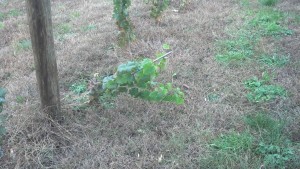
In the wake of Hurricane Sandy, we found a number of vines had been blown over, and were now leaning down almost to the ground. Not good.
Two weekends ago, after a longer than usual absence, we arrived in Nelson Country to survey damage from Hurricane Sandy and prepare for the freezing weather that had been predicted for that weekend. My apologies for taking so long to get this post up, but sometimes life gets in the way. And what with my surgery and a heavy worload back at the office on my day job, Project Sunlight has been a bit neglected. But I promise to rectify that, starting with this post, which covers Mother Nature at her worst — a hurricane, followed by early frost.
I’ll start with Sandy. We felt lucky, especially considering the devastation in New York and New Jersey, to have escaped with so little damage. I once lived on the New Jersey shore, and worked in both Jersey and New York city, and I felt deeply for the people there who suffered so much. For us, in both Fairfax and Nelson counties, the most visible sign that a storm had passed through were the fallen limbs and branches that will likely provide a whole winter’s worthy of kindling. But that’s not to say we escaped scot-free. As we walked through the vineyard, we saw a number of vines leaning sideways, in some cases almost to the ground. And no, that’s not a good thing. Continue Reading–>
Natural Wine, part I: Alice Feiring’s “Naked Wine”
Alice Feiring: Naked Wine
One of the most arresting moments in Alice Feiring’s book on natural wine is occasioned by a question she posed to Jacque Neauport, one of the movement’s pioneers, on what motivated him to make wine without sulfur. He is momentarily speechless, 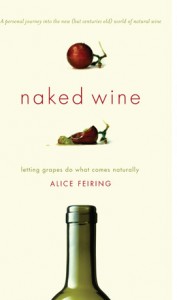 then nearly convulsed with laughter.
then nearly convulsed with laughter.
“Because we were drunkards!” he finally responds, explaining that they hoped that wine without sulfur would allow them to drink heavily and avoid hangovers. Ms. Feiring is clearly shocked. “I had come to the oracle for answers, and all he had for me was a punch line,” she writes.
There’s something disarming about these passages, although I suspect that readers who have been put off by her writing style and dogmatic approach to natural wine will take some pleasure in her discomfort. My reaction was different. I’m not sure I would have had the courage or confidence to retell a story like this, so it made me like her, as well as her book, a good deal more than I had up to that point.
Early on, I wondered if I would be able to recommend Naked Wine, or for that matter, even finish it. Her book is written in the style of a blog, and it is infused with her personality. If you happen to like that personality, you will probably like the book. If you find her style, as a friend of mine did, “annoying,” then you will find much of the book insufferable.
At the end, I’m somewhere in the middle. The book is definitely not for everyone, but for those interested in making an initial foray into the world of natural wine, it’s a pretty good introduction. Continue Reading–>
No Grow Tubes, No Round Up, No Sweat. (Well, maybe a little.)
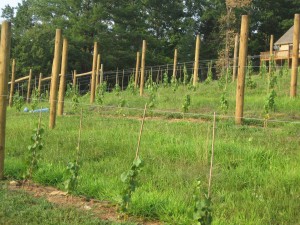
A view of our vineyard
We decided a year ago, after planting a small, educational vineyard (i.e., seven vines, planted for the sole purpose of getting some hands-on experience with viticulture) to forego the use of grow tubes. That was a tough choice. Almost every vineyard we’ve visited nurtures young vines in grow tubes, and there’s probably good reason to use them in large commercial undertakings.
But we decided against them for our small hobby vineyard for reasons that we think make sense. Most of the research we’ve looked at suggests that vines raised without grow tubes do better in the long run than those that spend their formative months inside protective shelters. We happened to speak to a vintner from South Africa over the weekend, and he echoed our views, noting that he had not even seen a grow tube before arriving in the United States. He still believes, he said, that the vines are better off without them.
But, of course, everything comes with a price. And this weekend, we got a real taste of the price you pay for growing vines without protective shelters.
The main reason vineyards love grow tubes is because it makes cultivation easy. You can spray herbicides such as Round Up around the vine to kill off the weeds without having to worry that your Cab Franc will die with them. Okay, I know that’s not a controversy-free statement. Advocates of organic wine, natural wine, biodynamic farming and so on will object right off the bat to the use of herbicides, however easy they make the task of maintaining a vineyard. And my heart is mostly with them, for a variety of reasons I’ll explore in future posts. But the fact is, keeping the weeds down without Round Up can be just plain drudgery.
Trust me, I have the aching muscles to prove it.
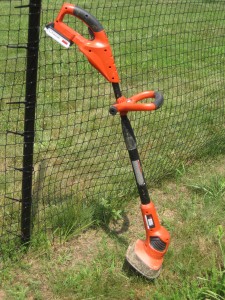
Our battery-powered cultivator, standing tall and proud
Now, it’s true that our vineyard is small. Right now we have only 150 vines, and the space they take up wouldn’t fill a small corner of even the smallest of the Commonwealth’s commercial vineyards. So we thought we could afford a few luxuries when it came to maintaining the vineyard. But it turns out that pulling weeds by hand is work – really, really, really hard work.
We started off a few weeks ago with nothing more than a hoe and our own hands. And by “we,” I mean my wife, the Vineyard Goddess, as I was still recovering from surgery on my cervical spine (Level 4 ACDF for those of you who know or care about these things). I was there in spirit, but it was the Vineyard Goddess who was working the soil with a hoe, and then kneeling down to pull the weeds by hand. I wasn’t actually there, but I have no doubt that it was slow, painful work.
And I know that, because we talked about it. I might have been unable to do physical labor, but I was still available as a consultant, and it occurred to me that there might be mechanical devices to help with this chore. Sure enough, there are. My preference would have been a small, gas-powered cultivator, but with our very steep slopes, we were concerned that we wouldn’t be able to control it well enough to avoid damage to the vines.
We looked at the somewhat smaller electrical tillers, both corded and battery-powered, and settled on the latter. The corded ones are probably perfect for a garden located next to the house, but our vineyard is a significant hike from the house. And the furthest rows are, as they say, “a fur piece.” Continue Reading–>
Pruning and training first-year vines
First-Year Vines Need Lots of Care
I’m still in the process of recovering from surgery and so unable to travel or tend a vineyard, but it turns out the vines are growing perfectly well without me. Who knew?
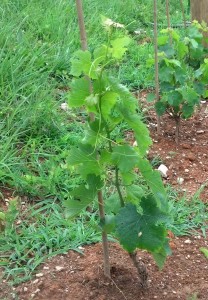
Here’s what one of the Cab Franc vines looked like before it was pruned and tied. You can see the tendrils caught the training stake and are holding it straight.
Still, young vines still need lots of care. In my absence, Chris, the Vineyard Goddess, and daughter Kate were on site in Afton last weekend to prune the vines, tie shoots to the training stakes and handle other assorted chores (mowing and spraying, among them), and once again they provided pictures and a full report from the front.
Tying the shoot to the training stake is an essential part of the vine’s development, and it turns out that there’s more than one approach to pruning and training first-year vines. Tony Wolf’s Wine Grape Production Guide for Eastern North America, for example, suggests leaving two or three shoots on the young vine, so that you’ll have something left if deer or other predators find their way into the vineyard and begin chowing down, or if one or more shoots simply break.
Wes Hagen, Clos Pepe’s vineyard manager and a regular columnist for WineMaker magazine, suggests a different approach. Choose the best of the shoots, tie it to the training stake and then – once you are certain that the shoot you’ve chosen is safely on the stake – prune away the remaining shoots and any swelling buds. We went with this approach, and hopefully we’ll finish the season with strong and relatively straight trunks to support the vines in the years to come.
You can see the results in the photos.
I remain hopeful that in another week or so I’ll be able to see the new vines for myself, but for now, it’s nice to know that they’re independent enough to carry on without me. And also nice to know that Kate is able to handle the mowing activities. Believe me, handling a lawnmower on a 15-20 degree slope is no picnic, and I won’t be in a position to use the tractor for a number of months. (Driving a tractor across the slopes is no picnic either; the pucker factor is always present!)
All of the nearby pictures were taken before she mowed, so the vineyard is looking a bit ragged in these shots. The rows themselves are pretty clean (with the possible exception of the Mammolos), although in some pictures, the camera angle makes it look otherwise.
By the way, keeping the rows clean can be a challenge. We decided not to use grow tubes to protect the vines, so spraying in the row with Roundup or another herbicide is more difficult and probably out of the question. However, our vineyard is small enough that we’re hoping to keep the rows clean by hand. (We’ll be getting out the hoe next visit — and probably the kneepads too, since at some point we’ll undoubtedly be down at ground level pulling weeds by hand!)
The Great Experiment — Transplanting Cab Franc
Another busy weekend in the vineyard. We transplanted four Cab Franc vines from Fairfax, researched and ordered a deer fence, and installed the bottom, or fruiting wire on our trellises in Afton. And, of course, we spent some time admiring the fruit of our labors from the previous few weeks – 150 new vines buried under mounds of dirt. The reds, which
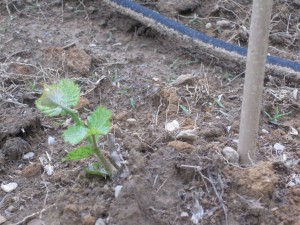
Three weeks after planting, the Viognier, pictured here, and the Petit Manseng, are emerging from the mounds of dirt that protected them from the spring frosts.
we planted two weekends ago, were still hidden away, but the whites we planted a week earlier – the Petit Manseng and the Viognier – were poking through the hills, and we were just thrilled to see them pushing through the earth! I have to say, they emerged from the mounds at just the right time, avoiding the frost that killed off our two prize Mammolo Toscano vines the previous weekend. Frost is an issue that we’ve been giving a lot of thought to after our experience this winter, and it influenced our decision on where to locate the fruiting wire. More on that in a future post.
For today, I’ll simply focus on our grand experiment, the transplanting of four of our Cab Franc vines from Fairfax to the Afton vineyard. We had planted a total of seven Cab Francs in Fairfax to get a bit of hands on experience close to home. I suppose at the back of my mind I thought I might eventually make a little wine from those vines, but mostly I
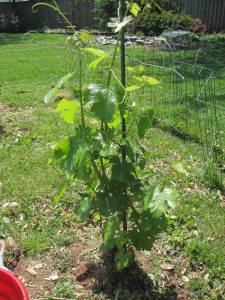
The Fairfax vines looked magnificent this Spring -- if a bit unruly. They need to be pruned, but that, I decided, would wait until they reached their new home.
wanted the experience of being able to go out in the evening after work to care for them and learn from that effort. We planted another five of the same clone and rootstock in Afton to see how the same vines would do in a different environment.
The Fairfax vines grew fast and they looked just beautiful. Clearly, the soil in Fairfax is rich, lending itself to high vigor growth. That’s good and bad, but probably mostly bad. It’s great to see the vines shoot up quickly, but ideally, we’d like them to struggle a bit so that the energy of the plant goes toward the grapes, not the vine itself. Left to its own, the vine will grow as high as it can find support – up a tree, for example, pushing toward the sunlight – but spectacular as that vine might be, Continue Reading–>
Planting the Vineyard, Part I
With the trellis posts finally in the ground, we were finally ready to plant. And not a moment too soon.
When we arrived in Afton on Friday evening, March 30, we had 50 dormant vines waiting for us: 25 Petit Manseng from Vintage Nurseries in Wasco, California, and 25 Viognier from Sunridge Nurseries, Bakersfield, California. The largest number of vines we had ever planted before was seven, and we weren’t sure how long it would take to get
these vines in the ground, or even if we’d be able to get it done by the end of the weekend. But we had another 100 vines set to arrive the following weekend, which meant we didn’t have much of a choice. We decided to plant the Petit Manseng first, and prepared them by putting them in a bucket of water to soak overnight.
In the morning, we inspected the vines to see if they looked healthy. This was kind of like the time in high school when my car wouldn’t start as I was taking my date home. I opened the hood, looked inside as though I knew what I was doing, and just prayed it would start when I got back in the car. It did start up, Continue Reading–>
Building the Trellis, Part I
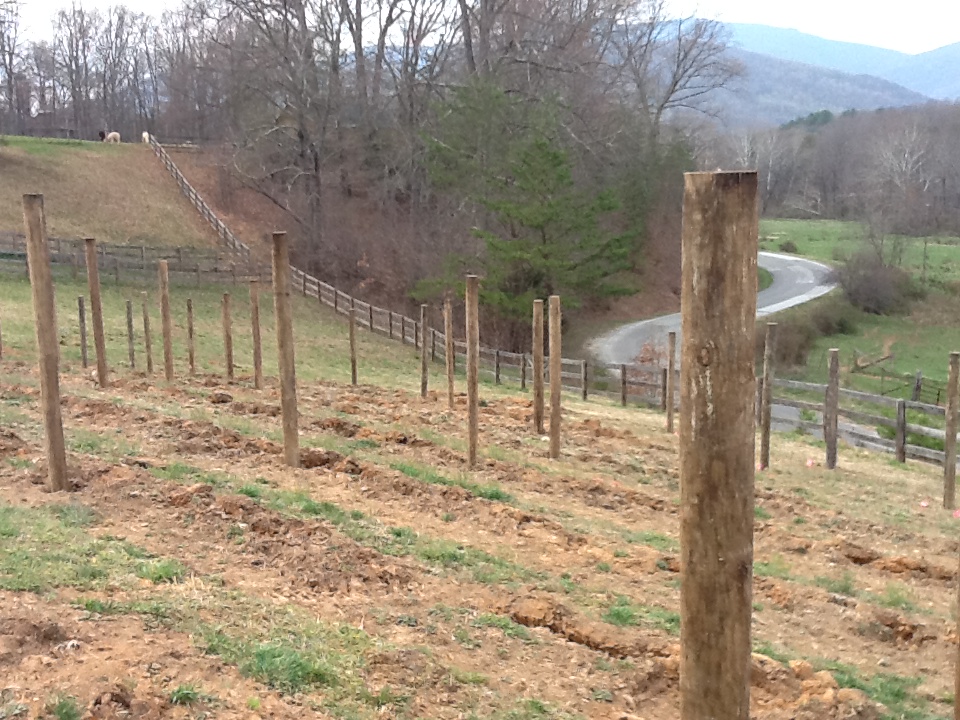
Here's how the vineyard looked last weekend, March 17. The posts are in the ground, the rows have been ripped, and it's beginning to look like a real vineyard! You can see our neighbors, the Alpacas, on the hill, top left.
How we built the trellis
Well, I have to be honest, I didn’t exactly build it myself. Much as I wanted to install the posts with my own hands, I ended up short on time with the planting season upon us. We needed to get the vines in the ground, pronto.
I’d spent much of the winter, between viticulture classes, my job and all of the work that goes into maintaining two separate properties, thinking about how to handle the trellis. There were moments when it seemed simple enough — eight foot posts put 24 to 30 inches into the ground, plus some kind of end-post system, which would be only slightly more complicated. And then, there were times when I wondered if I was up to the job.
As part of the planning, I did some research on what kind of equipment I’d need to buy or rent. A lot of the literature suggests that the best way to put posts into the ground is to pound them in, but the equipment involved would have made that impractical for me to do on my own. The easiest way to get the posts in is to drill the holes with an auger.
So, I briefly considered the idea of a hand-held power auger, which was the least expensive approach, or an auger for my tractor. I spent a lot of time visualizing the process, and considering whether it would be more cost-effective to do it myself or hire someone to do the work. I was pretty confident I could get the line posts in without a problem, but I spent a lot more time worrying about the end posts, which are more complicated. At some point, I began waking up at 4 a.m. to worry about how much work needed to be done and wonder if the vines we had ordered were destined to just, uh, rot on the vine? No, bad metaphor. Go to seed? mmmm…. no, that doesn’t work either. Wither and die? Well, something like that.
Eventually, we passed the point where I could reasonably expect that it would be Continue Reading–>

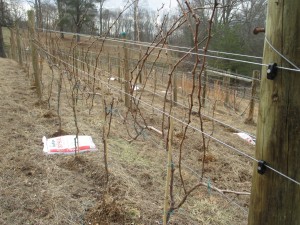
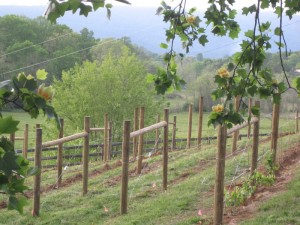
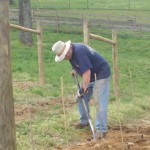
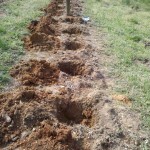
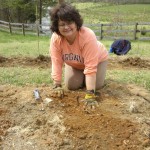
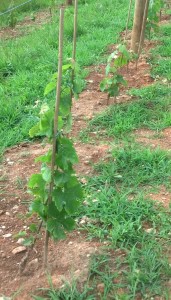

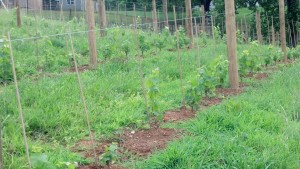
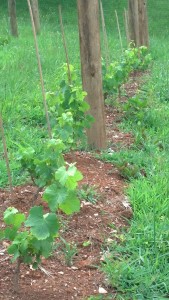
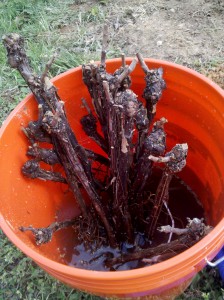
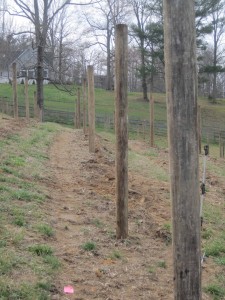


Recent Comments